- written by guest blogger, Angela Gardner after a farm tour in April 2013.
Driving along highway 10, through the Lake Maumelle Watershed and towards the misty convergence of Ozark and Ouachita hills, Sam Hedges and I quickly find ourselves immersed into the rural landscape of Perry County. We have ventured out of the city to visit two farms nestled into this land and gain an understanding of how these sustainable powerhouses supply numerous retail and business operations in central Arkansas. Our first stop for the day is Farm Girl Natural Foods operated by Katie Short and company.
Growing up in Berkeley, California, immersed into a developed culture of local food and liberalism, Katie intuitively knew that she was a farmer, connecting her aptitude for natural science and creative work with her hands. As a teenager she notes the homogeneous urban elite identity that was created over the years as budding a curiosity and rising to see a new world of “true salt of the Earth” farmers. With the local food markets already established by veteran farms and affordable productive land hard to find, Katie decided to venture out of Berkeley and seek opportunities where a young farmer could experiment, learn and work with the land. Her first (and only) stop was Heifer Ranch, the launching pad for Farm Girl.
Over the years, the success of Farm Girl has expanded to a 30 acre wooded homestead where we first meet Katie. She leads us into their new farm store, built out of sweat equity and filled with freezers for meat shares, milk jars and timeboards for the farm. Every Thursday from 10am-6pm, the store provides customers an opportunity to come out and deepen their ‘farm-to-table’ experience. Bring the whole family for a great educational day trip!
Venturing out of the building, Sam and I, though ill prepared for the terrain and weather, set forth into the scrubby forestland in wonder at what may lie beyond the grassy slope. Through the clearings, Katie points out the landscape impact hogs create under a woodland grazing rotation. These porkers do a fantastically efficient job of clearing out understory brush, providing an ample opening to reseed the area in regionally appropriate cover crops. This cooperative act of clearing and reseeding in rye and clover helps to enrich the properties and nature of soil by replenishing nutrients to the surface layer, and, I might add, it’s nicer on the ankles to romp through.
Approaching an undisturbed section of woodlot, we are introduced to the first litter of hogs busily roaming the new terrain of lush wilderness. The pigs are rotated to a new 1 acre area twice a week in order to maximize grazing, add nutrients to the land (in the form of manure) and limit soil compaction. For all of their livestock, Farm Girl uses mobile electrical fencing for pasture rotation as it is easy to work with and adaptable for any terrain. At (4) months old they had not yet ventured too far from the grain feeder but had already started working on the vegetation. The pigs associate the grain feeder as a ‘home base’, a familiar comfort zone, when they move into the new lots. The grain is supplied as a supplement to their diet to ensure they are receiving all the nutrients that are required for their growing bodies. These are some of the healthiest and most inquisitive pigs in the region. They are a mix of 4-5 different breed lines that Katie has been experimenting with over the years in order to select physicality traits that work best for her operation as well as the overall innate nature of the pigs she raises. She tells us that she is particularly fond of the red haired pigs as they seem to cope with the sun and heat better than their fair and dark haired cousins.
Deep snarls and grunts reverberate through the trees as Katie leads us up the hill to visit the breeder pen. Sam and I meet Buster, all 3,600 lbs of him, and stand in awe at the shear amount of life in front of us. He shares the pen with three sows, one of whom, Mudpie, is due to deliver soon. Beneath this canopy of trees, another litter will soon begin their journey from woodlot to woodlot, grazing to their hearts’ content while frolicking amongst the clover.
Pigs are a big market for Farm Girl but chickens certainly have their share of conscious nurturing from brooding to customer. The chicks that are raised at Farm Girl are purchased from S & G Poultry, who specialize in breeding chickens for southern US pastures. Red Rangers and Naked Neck (or Poulet Libre) are the broilers and Grey Ladies are the lead laying flock that Katie has purchased from S&G. While sitting in the brooder surrounded by 300 baby chicks, we learn that these ‘classic’ varieties are traditionally bred and raised to naturally maximize their potential physical nature (equates to a more developed flavor and natural growth development) whereas most conventional chicken operations use breeds that were developed for speedy frankenstein-ish growth habits that are not only are detrimental to the health and wellbeing of the animal but also distort our concept of humane agricultural production. She understands that agriculture is a business and needs to be profitable and by focusing on these varieties of chicks and livestock, Farm Girl Foods is paving a middle ground for the community. By being built upon this ethical foundation for all of their animals, Farm Girl Natural Foods has recently been granted their Animal Welfare Approved status. Way to go Farm Girl!
For the final leg of the Farm Girl tour, Katie takes us to Heifer Ranch where we journey towards 10 acres of the Fourche La Fave River Bottoms leased to Farm Girl for their cattle and roaming chickens. Along the way, the mist begins to accumulate into light rain droplets and as the breeze flies through the fields I again realize that I should have brought a jacket…..what a chilly spring we have had this year.
Stepping out onto the land toward the chicken pasture, my eyes soak up the blurred scenescape of rolling mist, clouds and green hills. Our route through the tree break creates a corridor of vibrant colors and sounds as the wind blows the pine branches 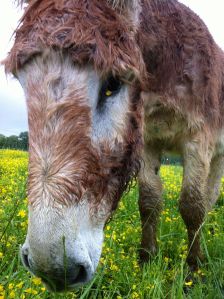 above us. This technique of planting trees along the fence row provides not only an aesthetic function but multiple purposes for the farmer: a wind break, shade for livestock and firewood. Breaking through the pathrow of pines, Katie takes us onto a fenced patch of land where the mobile chicken coops are housed. Currently there are 2 houses in production with two more houses ready for action. After 2 weeks in the brooder, the chickens are relocated to a mobile chicken house where they are moved twice daily with the help of a living tractor: the antiquated farm donkey. Again Katie points out the lush vegetated patches where the chickens have moved through providing generous nutrients for cover crop reclamation.
above us. This technique of planting trees along the fence row provides not only an aesthetic function but multiple purposes for the farmer: a wind break, shade for livestock and firewood. Breaking through the pathrow of pines, Katie takes us onto a fenced patch of land where the mobile chicken coops are housed. Currently there are 2 houses in production with two more houses ready for action. After 2 weeks in the brooder, the chickens are relocated to a mobile chicken house where they are moved twice daily with the help of a living tractor: the antiquated farm donkey. Again Katie points out the lush vegetated patches where the chickens have moved through providing generous nutrients for cover crop reclamation.
 above us. This technique of planting trees along the fence row provides not only an aesthetic function but multiple purposes for the farmer: a wind break, shade for livestock and firewood. Breaking through the pathrow of pines, Katie takes us onto a fenced patch of land where the mobile chicken coops are housed. Currently there are 2 houses in production with two more houses ready for action. After 2 weeks in the brooder, the chickens are relocated to a mobile chicken house where they are moved twice daily with the help of a living tractor: the antiquated farm donkey. Again Katie points out the lush vegetated patches where the chickens have moved through providing generous nutrients for cover crop reclamation.
above us. This technique of planting trees along the fence row provides not only an aesthetic function but multiple purposes for the farmer: a wind break, shade for livestock and firewood. Breaking through the pathrow of pines, Katie takes us onto a fenced patch of land where the mobile chicken coops are housed. Currently there are 2 houses in production with two more houses ready for action. After 2 weeks in the brooder, the chickens are relocated to a mobile chicken house where they are moved twice daily with the help of a living tractor: the antiquated farm donkey. Again Katie points out the lush vegetated patches where the chickens have moved through providing generous nutrients for cover crop reclamation.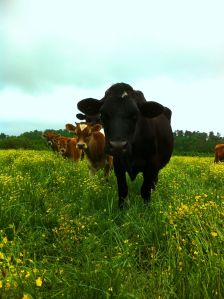 Heading to the last pasture of our tour, we follow Katie towards a mob of grazers: Jersey cows, a donkey and a Shetland pony. Being managed by a practiced grazier, this ultra high density forage-cattle interaction, know as mob grazing, produce quality gains for cattle (a grass-fed diet) and much higher than average gains from the land (a manure-fed diet). As Katie talks about how she utilizes the Jersey breed for both milk and meat, the donkey makes a bee line straight for us. After a few pets and acknowledgements of our attention, we learn more about the efficient physiology of Jersey cows to convert grass into fat providing both flavor and marbling that customers seek in meat products as well as flavor and fat content for milk products. These cattle are rotated through the pastures twice a day and are milked every morning. Milk shares are a new venture at Farm Girl, for more information please contact Katie Short. Be sure to check out their blog.
Heading to the last pasture of our tour, we follow Katie towards a mob of grazers: Jersey cows, a donkey and a Shetland pony. Being managed by a practiced grazier, this ultra high density forage-cattle interaction, know as mob grazing, produce quality gains for cattle (a grass-fed diet) and much higher than average gains from the land (a manure-fed diet). As Katie talks about how she utilizes the Jersey breed for both milk and meat, the donkey makes a bee line straight for us. After a few pets and acknowledgements of our attention, we learn more about the efficient physiology of Jersey cows to convert grass into fat providing both flavor and marbling that customers seek in meat products as well as flavor and fat content for milk products. These cattle are rotated through the pastures twice a day and are milked every morning. Milk shares are a new venture at Farm Girl, for more information please contact Katie Short. Be sure to check out their blog.
At Farm Girl, they are aspiring to capture the land of their flocks and herds, the ‘terroir’ of Perry County. Try their offerings of sausages, chicken, pork or beef available on littlerock.locallygrown.net, Argenta & Bernice Garden Farmer’s market and see if you can taste the place. Before we head onto the next leg of the journey, Sam and I give a cheer to real food with fresh raw milk and share our delight of this liquid ice cream that only Jersey cows grazing on the county of Perry County flora can naturally express.
Savor local flavor y’all!
by Angela Gardner


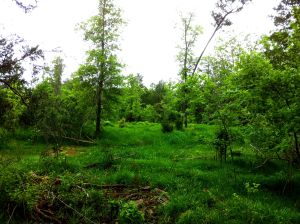
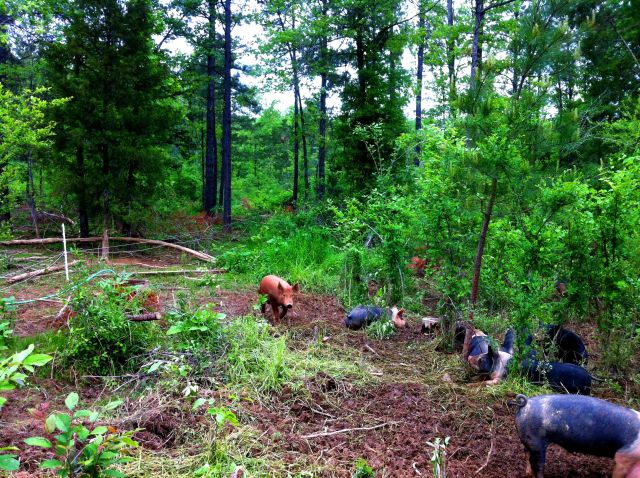
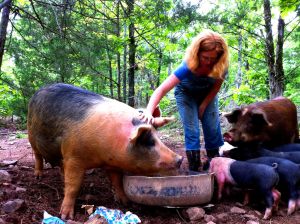

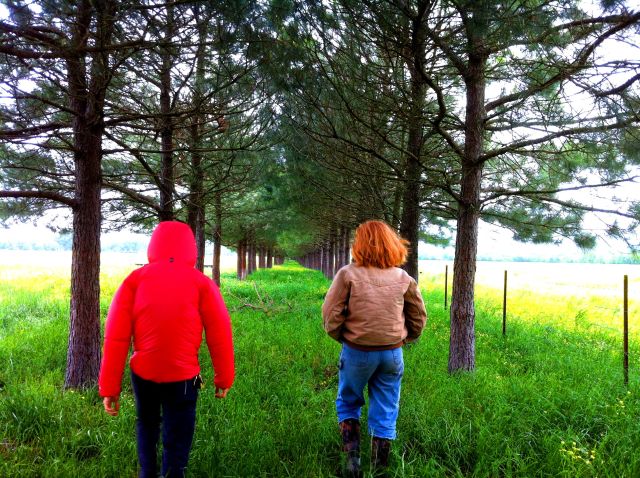
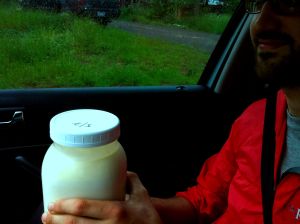
No comments:
Post a Comment